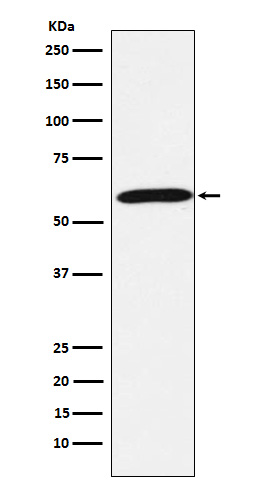Anti-Calsequestrin 1 Monoclonal Antibody
- SPECIFICATION
- CITATIONS
- PROTOCOLS
- BACKGROUND

Application
| WB, IHC, FC |
|---|---|
| Primary Accession | P31415 |
| Host | Rabbit |
| Isotype | Rabbit IgG |
| Reactivity | Rat, Human, Mouse |
| Clonality | Monoclonal |
| Format | Liquid |
| Description | Anti-Calsequestrin 1 Monoclonal Antibody . Tested in WB, IHC, Flow Cytometry applications. This antibody reacts with Human, Mouse, Rat. |
| Gene ID | 844 |
|---|---|
| Other Names | Calsequestrin-1, Calmitine, Calsequestrin, skeletal muscle isoform, CASQ1, CASQ |
| Calculated MW | 45160 Da |
| Application Details | WB 1:1000-1:5000 IHC 1:50-1:200 FC 1:100 |
| Contents | Rabbit IgG in phosphate buffered saline, pH 7.4, 150mM NaCl, 0.02% sodium azide and 50% glycerol, 0.4-0.5mg/ml BSA. |
| Clone Names | Clone: AEGE-3 |
| Immunogen | A synthesized peptide derived from human Calsequestrin 1 Calsequestrin is a high-capacity, moderate affinity, calcium-binding protein and thus acts as an internal calcium store in muscle. The release of calcium bound to calsequestrin through a calcium release channel triggers muscle contraction. Binds 40 to 50 moles of calcium. Also binds laminin. |
| Purification | Affinity-chromatography |
| Storage | Store at -20°C for one year. For short term storage and frequent use, store at 4°C for up to one month. Avoid repeated freeze-thaw cycles. |
| Name | CASQ1 |
|---|---|
| Synonyms | CASQ |
| Function | Calsequestrin is a high-capacity, moderate affinity, calcium- binding protein and thus acts as an internal calcium store in muscle (PubMed:28895244). Calcium ions are bound by clusters of acidic residues at the protein surface, often at the interface between subunits. Can bind around 80 Ca(2+) ions (PubMed:28895244). Regulates the release of lumenal Ca(2+) via the calcium release channel RYR1; this plays an important role in triggering muscle contraction. Negatively regulates store-operated Ca(2+) entry (SOCE) activity (PubMed:27185316). |
| Cellular Location | Endoplasmic reticulum Sarcoplasmic reticulum. Sarcoplasmic reticulum lumen {ECO:0000250|UniProtKB:P07221}. Sarcoplasmic reticulum membrane; Peripheral membrane protein; Lumenal side {ECO:0000250|UniProtKB:P07221}. Mitochondrion matrix {ECO:0000250|UniProtKB:O09165}. Note=This isoform of calsequestrin occurs in the sarcoplasmic reticulum's terminal cisternae luminal spaces of fast skeletal muscle cells. Preferentially forms linear and round aggregates in the endoplasmic reticulum (ER) of resting cells (PubMed:28895244). In a minority of cells, homogeneously detected in the ER lumen (PubMed:28895244). Colocalizes with STIM1 at endoplasmic reticulum in response to a depletion of intracellular calcium (PubMed:27185316). {ECO:0000250|UniProtKB:P07221, ECO:0000269|PubMed:27185316, ECO:0000269|PubMed:28895244} |
| Tissue Location | Expressed in myoblasts (at protein level). |

Thousands of laboratories across the world have published research that depended on the performance of antibodies from Abcepta to advance their research. Check out links to articles that cite our products in major peer-reviewed journals, organized by research category.
info@abcepta.com, and receive a free "I Love Antibodies" mug.
Provided below are standard protocols that you may find useful for product applications.
If you have used an Abcepta product and would like to share how it has performed, please click on the "Submit Review" button and provide the requested information. Our staff will examine and post your review and contact you if needed.
If you have any additional inquiries please email technical services at tech@abcepta.com.













 Foundational characteristics of cancer include proliferation, angiogenesis, migration, evasion of apoptosis, and cellular immortality. Find key markers for these cellular processes and antibodies to detect them.
Foundational characteristics of cancer include proliferation, angiogenesis, migration, evasion of apoptosis, and cellular immortality. Find key markers for these cellular processes and antibodies to detect them. The SUMOplot™ Analysis Program predicts and scores sumoylation sites in your protein. SUMOylation is a post-translational modification involved in various cellular processes, such as nuclear-cytosolic transport, transcriptional regulation, apoptosis, protein stability, response to stress, and progression through the cell cycle.
The SUMOplot™ Analysis Program predicts and scores sumoylation sites in your protein. SUMOylation is a post-translational modification involved in various cellular processes, such as nuclear-cytosolic transport, transcriptional regulation, apoptosis, protein stability, response to stress, and progression through the cell cycle. The Autophagy Receptor Motif Plotter predicts and scores autophagy receptor binding sites in your protein. Identifying proteins connected to this pathway is critical to understanding the role of autophagy in physiological as well as pathological processes such as development, differentiation, neurodegenerative diseases, stress, infection, and cancer.
The Autophagy Receptor Motif Plotter predicts and scores autophagy receptor binding sites in your protein. Identifying proteins connected to this pathway is critical to understanding the role of autophagy in physiological as well as pathological processes such as development, differentiation, neurodegenerative diseases, stress, infection, and cancer.


